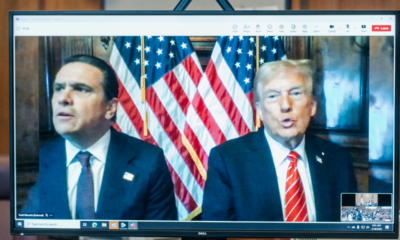Business
What Cuisine Means to Taiwan’s Identity and Its Clash With China

Taiwan is a self-ruling island of 24 million people that is officially known as the Republic of China. About only a dozen countries recognize it as a nation because China claims it as one of its provinces. Taiwan is called “Chinese Taipei” by international organizations and at the Olympic Games.
The ambiguity of Taiwan’s nationhood contrasts with a growing Taiwanese claim of identity. More than 60 percent of the people living on the island identify as Taiwanese, and roughly 30 percent identify as both Chinese and Taiwanese, according to the latest results of an annual survey conducted by National Chengchi University in Taipei. Only 2.5 percent consider themselves Chinese exclusively.
But what makes them Taiwanese, not Chinese? How will they create a cohesive narrative about their identity? And how do they reconcile with their Chinese heritage?
For many people, it’s through food, one of the things the island is known for, aside from its semiconductor industry. In the past decade or so, restaurateurs, writers and scholars have started to promote the concept of Taiwanese cuisine, reviving traditional fine dining and incorporating local, especially Indigenous, produce and ingredients into cooking.
They are articulating and shaping a culinary culture that’s distinct from that of China, highlighting a Taiwanese identity that’s organic, tangible and immersed in everyday life. The food embodies Taiwan’s yearning for recognition as a nation, or at least as a culture of its own.
“For years, Taiwan’s ‘nationhood’ has been an ambiguous concept,” Yu-Jen Chen, a food historian at National Taiwan Normal University in Taipei, wrote in a 2020 book. “And that makes the question ‘What Taiwanese cuisine is’ particularly interesting.” She said the efforts to define and shape the cuisine allowed the Taiwanese to “taste and feel the ‘nationhood.’”
Ian Lee is the owner and executive chef of the HoSu Restaurant in Taipei. HoSu means “good island” in the Taiwanese dialect, and he uses his menu to express his love of the land of Taiwan — its produce, terrain and aroma.
One of Mr. Lee’s dishes, a smoky chargrilled fish, draws inspiration from the cooking of the Atayal, one of many Indigenous groups in Taiwan. The rice noodle soup Dingbiancuo, a famous street snack, is elevated to a main course. Taiwanese mango is presented in the shape of the terraced fields where the decorative herb for the dessert is grown.
“I want the others to see how wonderful and vibrant Taiwan is by telling the stories of our homeland,” he said.
Mr. Lee believes his food could enhance the chances that the people of Taiwan will stand up to China, whose threat to take over the island by force is looking more real than it has in many decades.
“We have to help people identify with this land so a national identity could emerge eventually,” he said. “So if something happens, we will be willing to fight for our homeland.”
Nowhere does food exist independently from politics. After Mexico’s independence from Spain two centuries ago, the Mexican cuisine helped shape a national identity. In March, China’s top leader, Xi Jinping, said, “Whether the public can have vegetables on their tables is a political matter.”
In Taiwan, the idea of Taiwanese cuisine first appeared as a way to differentiate it from the cuisine of the island’s colonial Japanese rulers in the early 20th century. During the authoritarian rule of the Nationalist Party, or Kuomintang, Taiwanese food was considered a regional cuisine like that of Shanghai and Sichuan, but it held a lower status.
After the lifting of martial law in 1987, especially after Chen Shui-bian, a Taiwanese-born nationalist, was elected president in 2000, Taiwanese snacks were served at state banquets. Cuisines of Indigenous groups and Hakka people, a Han Chinese subgroup, began to rise, reflecting the inclusiveness of a new democracy.
Today, ask a dozen Taiwanese what Taiwanese cuisine means to them and you might get a dozen answers.
Ching-yi Chen, a food writer in Taipei, asked each attendee of an event to bring a dish that the person considered to be Taiwanese cuisine. A woman in her 20s brought mapo tofu, originally from China’s Sichuan Province, because she grew up eating it. An older pro-independence politician brought a bowl of eel noodle. That is a dish from Tainan, the stronghold of the ruling Democratic Progressive Party, which promotes Taiwanese nationalism.
To Ms. Chen, both qualified as Taiwanese cuisines. “Anything on this land that is transformed and given a new form or life can be referred to as ‘Taiwanese cuisine,’” she said.
She pointed to the prevalence of miso soup in Taiwanese meals, a vestige of the Japanese colonial rule. In Taiwan, the soup can go with cold noodles, glutinous rice dumplings and even meatballs, she said, something that probably would not happen in Japan.
“The reinterpretation makes it a new dish and part of Taiwanese cuisine,” she said.
For both Taiwanese cuisine and identity, the trickiest aspect is how to reconcile with its Chinese heritage.
“For me, the Chinese government and my Chinese ancestors are two separate things,” Ms. Chen said. “As much as we want to stay away from the Chinese government, most people probably won’t go as far as disowning their ancestors.”
For the most part, Taiwanese people seem to be at ease with their Chinese heritage. The streets of Taipei can feel like any city in southern China. Most people speak Mandarin Chinese even though the Taiwanese dialect is gaining popularity. Many roads and places are named after Chinese provinces. I stayed at a hotel on Jilin Road and ate pork liver soup at a night market named after my home region, Ningxia.
Many restaurants in Taipei claim to offer Sichuan, Hunan and Shanghai cuisines. But for those mainland Chinese who are looking for “authentic” regional Chinese food, they’re in the wrong place.
The dishes at a Hunan restaurant are not spicy at all. The Shanghai restaurant at the Shangri-La Hotel in Taipei is excellent. But the most memorable dish, for me, was steamed glutinous rice with mud crab, a signature Taiwanese dish.
A place where many Indigenous languages are spoken, and the first in Asia to allow same-sex marriage, Taiwan is an inclusive society. So is its cuisine. It’s fusion, or anything goes, said Jewel Tsai, another Taipei food writer.
“That’s why it’s difficult to define Taiwanese cuisine,” she said. “How are you going to define something that’s ever expanding like a snowball?”
One group in the movement is elevating original Taiwanese cuisine, which was diminished and looked down on during the more than half-century of political repression of Taiwanese civilians under the rule of Kuomintang. Taiwanese elites were killed or jailed. Speaking the Taiwanese dialect in schools was subject to fines. High-end Taiwanese restaurants were converted into public canteens to accommodate the two million mainlanders who evacuated to the island after the Kuomintang lost the civil war to the Communist Party in 1949.
Chefs at Mountain and Sea House, a fine dining restaurant that opened in Taipei in 2014, tracked down old recipes and reincarnated traditional Taiwanese banquet dishes from a century ago. One of its most exquisite items is a vegetable bun made of interweaving bottle gourd and carrot slices and stuffed with black pork and mushrooms.
The most audacious efforts in Taiwanese cuisine are made by those like Mr. Lee, the owner-chef of HoSu restaurant, who try to elevate the Indigenous cooking and ingredients.
In the political debate, Taiwanese nationalists often emphasize the existence of the Indigenous groups as evidence that Taiwan has its unique origins, of which the Chinese culture is only a part, Yu-Jen Chen, the food historian, wrote in her book. Even though the Indigenous groups make up only 2 percent of Taiwan’s population, she wrote, they’re an important part in the narrative of Taiwanese nationhood.
Mr. Lee believes that the Ukrainians have put up a good fight against Russia because they identify strongly with their nationhood. He wants to use his cooking to advance the sense of Taiwanese identity.
“Everyone is a small screw,” he said. “We need to tighten and fasten these screws properly for the system to function normally. When the system operates smoothly, I believe the other side will be less inclined to engage in aggression or attempts to annex.”

Business
Cookies, Cocktails and Mushrooms on the Menu as Justices Hear Bank Fraud Case

In a lively Supreme Court argument on Tuesday that included references to cookies, cocktails and toxic mushrooms, the justices tried to find the line between misleading statements and outright lies in the case of a Chicago politician convicted of making false statements to bank regulators.
The case concerned Patrick Daley Thompson, a former Chicago alderman who is the grandson of one former mayor, Richard J. Daley, and the nephew of another, Richard M. Daley. He conceded that he had misled the regulators but said his statements fell short of the outright falsehoods he said were required to make them criminal.
The justices peppered the lawyers with colorful questions that tried to tease out the difference between false and misleading statements.
Chief Justice John G. Roberts Jr. asked whether a motorist pulled over on suspicion of driving while impaired said something false by stating that he had had one cocktail while omitting that he had also drunk four glasses of wine.
Caroline A. Flynn, a lawyer for the federal government, said that a jury could find the statement to be false because “the officer was asking for a complete account of how much the person had had to drink.”
Justice Ketanji Brown Jackson asked about a child who admitted to eating three cookies when she had consumed 10.
Ms. Flynn said context mattered.
“If the mom had said, ‘Did you eat all the cookies,’ or ‘how many cookies did you eat,’ and the child says, ‘I ate three cookies’ when she ate 10, that’s a false statement,” Ms. Flynn said. “But, if the mom says, ‘Did you eat any cookies,’ and the child says three, that’s not an understatement in response to a specific numerical inquiry.”
Justice Sonia Sotomayor asked whether it was false to label toxic mushrooms as “a hundred percent natural.” Ms. Flynn did not give a direct response.
The case before the court, Thompson v. United States, No. 23-1095, started when Mr. Thompson took out three loans from Washington Federal Bank for Savings between 2011 and 2014. He used the first, for $110,000, to finance a law firm. He used the next loan, for $20,000, to pay a tax bill. He used the third, for $89,000, to repay a debt to another bank.
He made a single payment on the loans, for $390 in 2012. The bank, which did not press him for further payments, went under in 2017.
When the Federal Deposit Insurance Corporation and a loan servicer it had hired sought repayment of the loans plus interest, amounting to about $270,000, Mr. Thompson told them he had borrowed $110,000, which was true in a narrow sense but incomplete.
After negotiations, Mr. Thompson in 2018 paid back the principal but not the interest. More than two years later, federal prosecutors charged him with violating a law making it a crime to give “any false statement or report” to influence the F.D.I.C.
He was convicted and ordered to repay the interest, amounting to about $50,000. He served four months in prison.
Chris C. Gair, a lawyer for Mr. Thompson, said his client’s statements were accurate in context, an assertion that met with skepticism. Justice Elena Kagan noted that the jury had found the statements were false and that a ruling in Mr. Thompson’s favor would require a court to rule that no reasonable juror could have come to that conclusion.
Justices Neil M. Gorsuch and Brett M. Kavanaugh said that issue was not before the court, which had agreed to decide the legal question of whether the federal law, as a general matter, covered misleading statements. Lower courts, they said, could decide whether Mr. Thompson had been properly convicted.
Justice Samuel A. Alito Jr. asked for an example of a misleading statement that was not false. Mr. Gair, who was presenting his first Supreme Court argument, responded by talking about himself.
“If I go back and change my website and say ‘40 years of litigation experience’ and then in bold caps say ‘Supreme Court advocate,’” he said, “that would be, after today, a true statement. It would be misleading to anybody who was thinking about whether to hire me.”
Justice Alito said such a statement was, at most, mildly misleading. But Justice Kagan was impressed.
“Well, it is, though, the humblest answer I’ve ever heard from the Supreme Court podium,” she said, to laughter. “So good show on that one.”
Business
SEC probes B. Riley loan to founder, deals with franchise group

B. Riley Financial Inc. received more demands for information from federal regulators about its dealings with now-bankrupt Franchise Group as well as a personal loan for Chairman and co-founder Bryant Riley.
The Los Angeles-based investment firm and Riley each received additional subpoenas in November from the U.S. Securities and Exchange Commission seeking documents and information about Franchise Group, or FRG, the retail company that was once one of its biggest investments before its collapse last year, according to a long-delayed quarterly filing. The agency also wants to know more about Riley’s pledge of B. Riley shares as collateral for a personal loan, the filing shows.
B. Riley previously received SEC subpoenas in July for information about its dealings with ex-FRG chief executive Brian Kahn, part of a long-running probe that has rocked B. Riley and helped push its shares to their lowest in more than a decade. Bryant Riley, who founded the company in 1997 and built it into one of the biggest U.S. investment firms beyond Wall Street, has been forced to sell assets and raise cash to ease creditors’ concerns.
The firm and Riley “are responding to the subpoenas and are fully cooperating with the SEC,” according to the filing. The company said the subpoenas don’t mean the SEC has determined any violations of law have occurred.
Shares in B. Riley jumped more than 25% in New York trading after the company’s overdue quarterly filing gave investors their first formal look at the firm’s performance in more than half a year. The data included a net loss of more than $435 million for the three months ended June 30. The shares through Monday had plunged more than 80% in the past 12 months, trading for less than $4 each.
B. Riley and Kahn — a longstanding client and friend of Riley’s — teamed up in 2023 to take FRG private in a $2.8-billion deal. The transaction soon came under pressure when Kahn was tagged as an unindicted co-conspirator by authorities in the collapse of an unrelated hedge fund called Prophecy Asset Management, which led to a fraud conviction for one of the fund’s executives.
Kahn has said he didn’t do anything wrong, that he wasn’t aware of any fraud at Prophecy and that he was among those who lost money in the collapse. But federal investigations into his role have spilled over into his dealings with B. Riley and its chairman, who have said internal probes found they “had no involvement with, or knowledge of, any alleged misconduct concerning Mr. Kahn or any of his affiliates.”
FRG filed for Chapter 11 bankruptcy in November, a move that led to hundreds of millions of dollars of losses for B. Riley. The collapse made Riley “personally sick,” he said at the time.
One of the biggest financial problems to arise from the FRG deal was a loan that B. Riley made to Kahn for about $200 million, which was secured against FRG shares. With that company’s collapse into bankruptcy in November wiping out equity holders, the value of the remaining collateral for this debt has now dwindled to only about $2 million, the filing shows.
Griffin writes for Bloomberg.
Business
Starbucks Reverses Its Open-Door Policy for Bathroom Use and Lounging

Starbucks will require people visiting its coffee shops to buy something in order to stay or to use its bathrooms, the company announced in a letter sent to store managers on Monday.
The new policy, outlined in a Code of Conduct, will be enacted later this month and applies to the company’s cafes, patios and bathrooms.
“Implementing a Coffeehouse Code of Conduct is something most retailers already have and is a practical step that helps us prioritize our paying customers who want to sit and enjoy our cafes or need to use the restroom during their visit,” Jaci Anderson, a Starbucks spokeswoman, said in an emailed statement.
Ms. Anderson said that by outlining expectations for customers the company “can create a better environment for everyone.”
The Code of Conduct will be displayed in every store and prohibit behaviors including discrimination, harassment, smoking and panhandling.
People who violate the rules will be asked to leave the store, and employees may call law enforcement, the policy says.
Before implementation of the new policy begins on Jan. 27, store managers will be given 40 hours to prepare stores and workers, according to the company. There will also be training sessions for staff.
This training time will be used to prepare for other new practices, too, including asking customers if they want their drink to stay or to go and offering unlimited free refills of hot or iced coffee to customers who order a drink to stay.
The changes are part of an attempt by the company to prioritize customers and make the stores more inviting, Sara Trilling, the president of Starbucks North America, said in a letter to store managers.
“We know from customers that access to comfortable seating and a clean, safe environment is critical to the Starbucks experience they love,” she wrote. “We’ve also heard from you, our partners, that there is a need to reset expectations for how our spaces should be used, and who uses them.”
The changes come as the company responds to declining sales, falling stock prices and grumbling from activist investors. In August, the company appointed a new chief executive, Brian Niccol.
Mr. Niccol outlined changes the company needed to make in a video in October. “We will simplify our overly complex menu, fix our pricing architecture and ensure that every customer feels Starbucks is worth it every single time they visit,” he said.
The new purchase requirement reverses a policy Starbucks instituted in 2018 that said people could use its cafes and bathrooms even if they had not bought something.
The earlier policy was introduced a month after two Black men were arrested in a Philadelphia Starbucks while waiting to meet another man for a business meeting.
Officials said that the men had asked to use the bathroom, but that an employee had refused the request because they had not purchased anything. An employee then called the police, and part of the ensuing encounter was recorded on video and viewed by millions of people online, prompting boycotts and protests.
In 2022, Howard Schultz, the Starbucks chief executive at the time, said that the company was reconsidering the open-bathroom policy.
-

 Health1 week ago
Health1 week agoOzempic ‘microdosing’ is the new weight-loss trend: Should you try it?
-
/cdn.vox-cdn.com/uploads/chorus_asset/file/25822586/STK169_ZUCKERBERG_MAGA_STKS491_CVIRGINIA_A.jpg)
/cdn.vox-cdn.com/uploads/chorus_asset/file/25822586/STK169_ZUCKERBERG_MAGA_STKS491_CVIRGINIA_A.jpg) Technology6 days ago
Technology6 days agoMeta is highlighting a splintering global approach to online speech
-

 Science4 days ago
Science4 days agoMetro will offer free rides in L.A. through Sunday due to fires
-
/cdn.vox-cdn.com/uploads/chorus_asset/file/25821992/videoframe_720397.png)
/cdn.vox-cdn.com/uploads/chorus_asset/file/25821992/videoframe_720397.png) Technology1 week ago
Technology1 week agoLas Vegas police release ChatGPT logs from the suspect in the Cybertruck explosion
-

 Movie Reviews1 week ago
Movie Reviews1 week ago‘How to Make Millions Before Grandma Dies’ Review: Thai Oscar Entry Is a Disarmingly Sentimental Tear-Jerker
-

 Health1 week ago
Health1 week agoMichael J. Fox honored with Presidential Medal of Freedom for Parkinson’s research efforts
-

 Movie Reviews1 week ago
Movie Reviews1 week agoMovie Review: Millennials try to buy-in or opt-out of the “American Meltdown”
-

 News1 week ago
News1 week agoPhotos: Pacific Palisades Wildfire Engulfs Homes in an L.A. Neighborhood


















